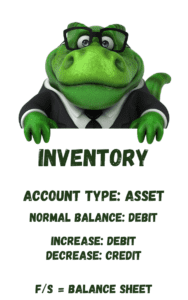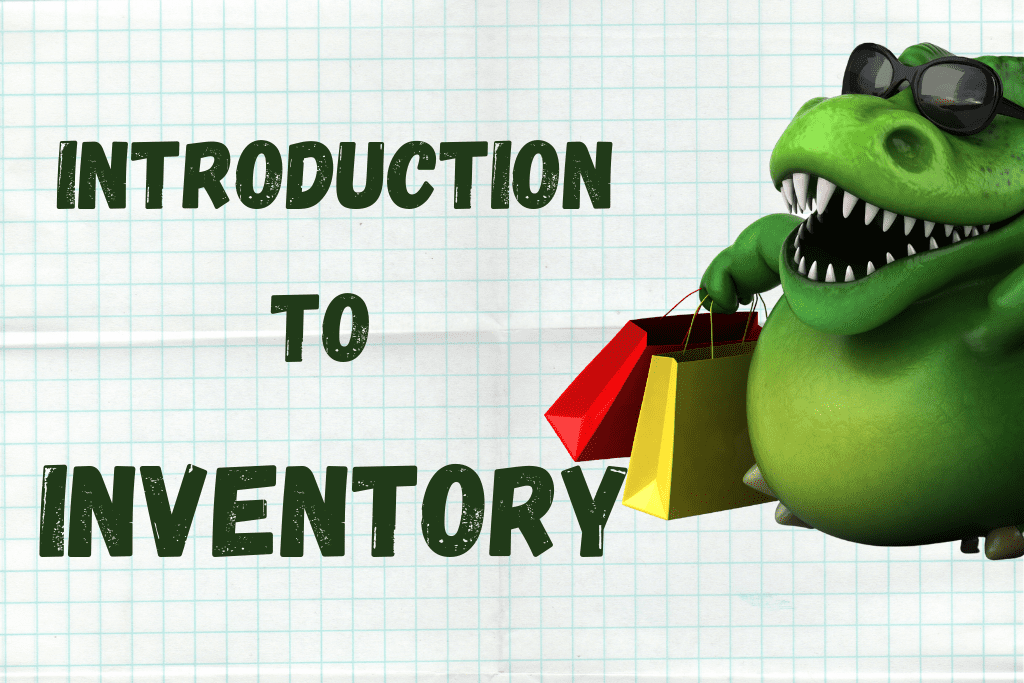Inventory is an accounting of items owned by a business that will either be sold to customers or converted from raw materials into items that will be sold to customers. Inventory is an asset. It has a normal debit balance. It increases on the debit side and decreases on the credit side.
Inventory accounts may be called by different names based on the type of business (service, merchandising, or manufacturing) and the purpose of the inventory. Common account names are:
- Inventory–a general term
- Merchandise Inventory–specific to businesses that buy and sell merchandise
- Raw Materials Inventory–specific to manufacturing businesses
- Work in Process Inventory–specific to manufacturing businesses
- Finished Goods Inventory–specific to manufacturing businesses
- Packaging Materials Inventory–specific to manufacturing businesses used to track packaging for products
- Maintenance, Repair, and Operations Inventory (MRO)—-specific to manufacturing businesses used to track other materials needed to produce products or keep machinery operating, for example extra machine parts

Inventory control is critical for businesses. Too much inventory means that cash is tied up and isn’t available for paying other bills or investing. Too little inventory means that sales are lost and cash doesn’t flow into the company. Too much or too little of the right mix of inventory can mean a business is overstocked on one item and out of stock on another.
For a manufacturing business running out of a key ingredient (steel or flour) can shut down the factory for production. Having too much of an ingredient can create storage costs or increased costs due to spoilage. It’s a delicate balance.
Periodic vs. Perpetual Inventory
One fundamental decision to be made is whether to track inventory using the Perpetual Inventory Method or the Periodic Inventory Method
What is Perpetual Inventory?
Under a perpetual inventory method, businesses typically scan merchandise as it comes into the warehouse, scan it as it leaves the warehouse, scan it as it comes into the store, and scan it when it goes through the cash register and out of the store. This allows the business to have an accurate reporting of how many of each item it has available for customers.
What is Periodic Inventory?
Under a periodic inventory method, a business tracks inventory once a month or once a year (periodically) by taking a physical count of all merchandise. The value of the inventory is compared to the previous inventory number and what was purchased. The difference between what was on hand, what was purchased, and what is remaining, provides the amount of inventory sold.
Because this method does not provide up-to-date business information, this method is only used by businesses with small amounts of inventory.
For a deeper understanding of Perpetual Inventory and Periodic Inventory methods, watch this video:
For the purposes of accounting classes, most of our focus is on tracking the movement of costs from Inventory to Cost of Goods Sold (manufacturing) or from Inventory to Cost of Merchandise Sold (merchandising.) We also determine the cost of that inventory based on three different methods of applying costs:
- FIFO–First in, First Out
- LIFO–Last in, First Out
- AVCO–Average Cost
To learn more about inventory in a Merchandising Business, check out this video:
-
What is Equity in Accounting and Finance?
In Accounting and Finance, Equity represents the value of the shareholders’ or business owner’s stake in the business. Equity accounts have a normal credit balance. Equity increases on the credit
-
Understanding Financial Statements | Accounting Student Guide
What is a Financial Statement? Financial Statements are a set of reports summarizing the activities of a business or organization. Much like a series of x-rays shows different views of
-
What is Treasury Stock?
Treasury Stock represents a corporation’s stocks that were previously issued and sold to shareholders. The corporation reacquires the stock by purchasing the stock from shareholders. Treasury Stock reduces the number
-
What is Stockholders’ Equity?
Stockholders’ Equity is the difference between what a corporation owns (Assets) and what a corporation owes (Liabilities). Stockholders’ Equity is made up of Contributed Capital and Earned Capital. Contributed Capital
-
What is Paid in Capital?
What is Contributed or Paid-in Capital? Contributed Capital is also called Paid-in Capital. It includes any amounts “contributed” or “paid in” by investors or stockholders through purchasing of stocks or
-
What is the Difference Between Debt Financing and Equity Financing?
When businesses needs funds to expand or grow the business, that capital can come from three sources: Funds from profits Funds from debt Funds from equity Funding business growth from

